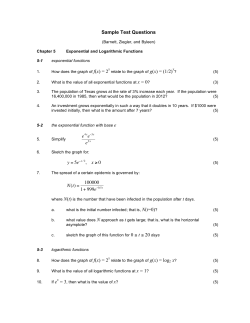
A direct estimate of the radial growth of stellar discs THEORY OBSERVATIONS
A direct estimate of the radial growth of stellar discs G. Pezzulli; F. Fraternali; S. Boissier OBSERVATIONS THEORY SAMPLE: 35 nearby spiral galaxies, with available NIR and (extinction-corrected) FUV profiles (Muñoz-Mateos et al. 2009 [1], data from the SINGS survey) IF stellar discs are exponential with a time-growing scale-length 1) Stellar mass surface density (Spitzer IRAC 3.6 μm) NGC2841 time STEP 1: Exponential fit of the disc mass surface density Measure , THEN the star formation rate should have a universal profile 2 parameters: - mass growth rate: 2) Star formation rate surface density (GALEX FUV + Spitzer MIPS bands) NGC2841 Central depression STEP 2: Fit of the theoretical SFR density Outer exponential - radial growth rate: Measure , RESULTS - 32/35 galaxies show positive radial growth - Mass and radial growth rates show only mild trends with mass and morphological type... ... but they are quite strongly correlated with each other! The solid line (NOT fitted to the data) is the expectation if: - the Tully-Fisher relation [2] - and the Fall relation [3] were not evolving with time CONCLUSIONS - SFR density profiles of spiral galaxies can be used to measure the growth rate of their exponential discs - The typical radial growth rate of a spiral galaxy is ~0.35 times its mass growth rate - Results are consistent with known scaling relations being universal (not evolving with time) References: [1] Muñoz-Mateos, J.C. et al. 2009, ApJ, 701, 1965M [2] McGaugh, S. 2012, AJ, 143, 40M [3] Romanowsky, A.J. & Fall, S.M. 2012, ApJS, 203, 17R
© Copyright 2025





















